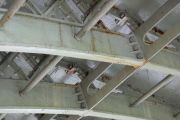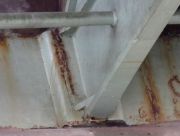Powick Bridge: Difference between revisions
No edit summary |
No edit summary |
||
| Line 3: | Line 3: | ||
[[Image:JD Powick11.jpg|thumb|]] | [[Image:JD Powick11.jpg|thumb|]] | ||
[[Image:JD Powick03.jpg|thumb|]] | [[Image:JD Powick03.jpg|thumb|]] | ||
[[Image:JD Powick04.jpg|thumb|The bolted flanged connections between individual rib sections can be seen in the shadows. See | [[Image:JD Powick04.jpg|thumb|The bolted flanged connections between individual rib sections can be seen in the shadows. The ribs spring from a common cast iron plate set into the abutment. See details below]] | ||
[[Image:JD 2024 08 15 Powick 1.JPG|thumb|]] | [[Image:JD 2024 08 15 Powick 1.JPG|thumb|]] | ||
[[Image:JD 2024 08 15 Powick 2.JPG|thumb|]] | [[Image:JD 2024 08 15 Powick 2.JPG|thumb|]] | ||
Latest revision as of 21:12, 16 August 2024














Powick, near Worcester
There are two bridges over the River Teme at Powick, the ancient 'Powick Old Bridge' and the 19th C. 'Powick New Bridge'. The site has much to offer the industrial history enthusiast.
Old Bridge
The old bridge crosses the River Teme and the millstream from Powick Mills. It is a skew bridge, from an era when realigning the road would have been the preferred option to avoid such complications. Skew bridges were to become an unavoidable necessity with the coming of canals and railways in the Industrial Revolution.
'The Happy Pontist'[1] provides a good account of the bridge.
New Bridge
Built 1836-7, opened 1838.
Engineer Charles Henry Capper.
The main span has seven cast iron arch ribs, with integral spandrels, each assembled from three sections. Fine foundrywork by W. Yates of Birmingham.

